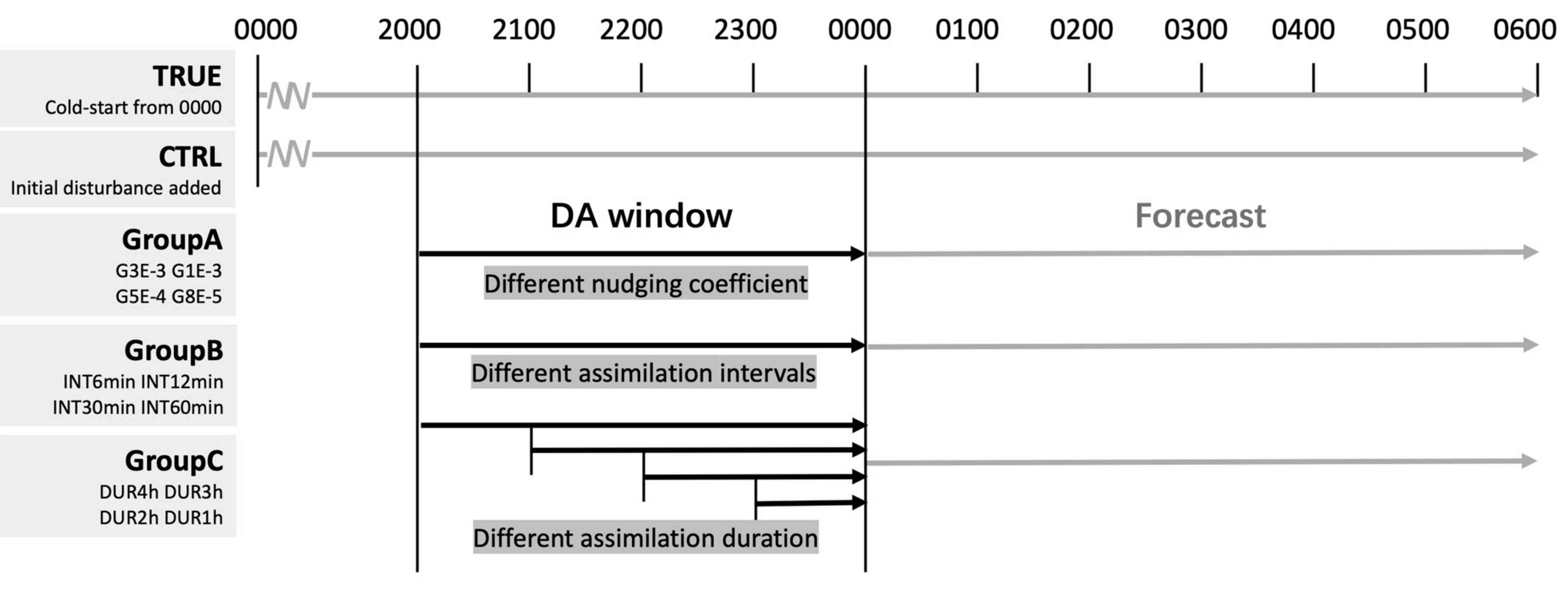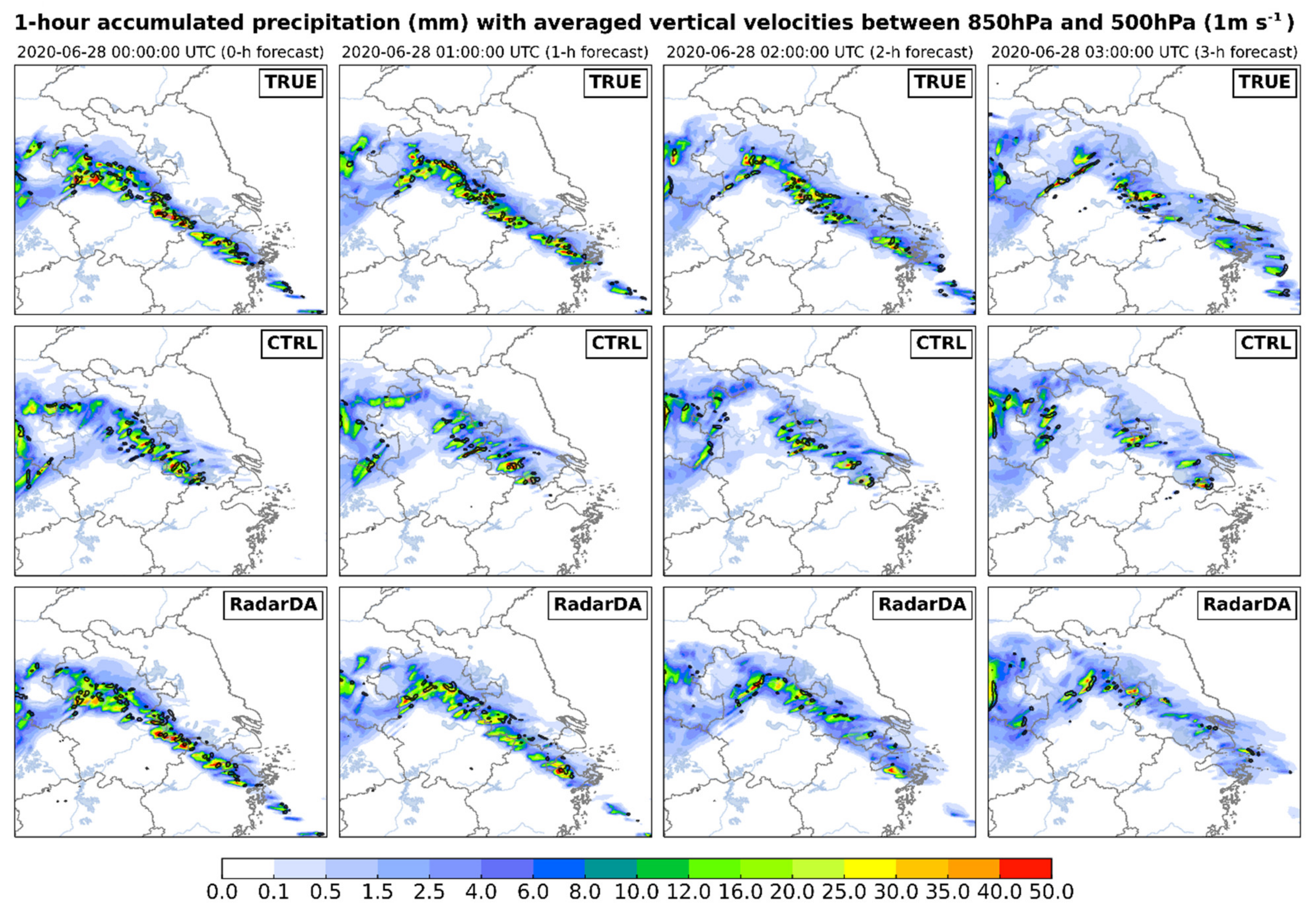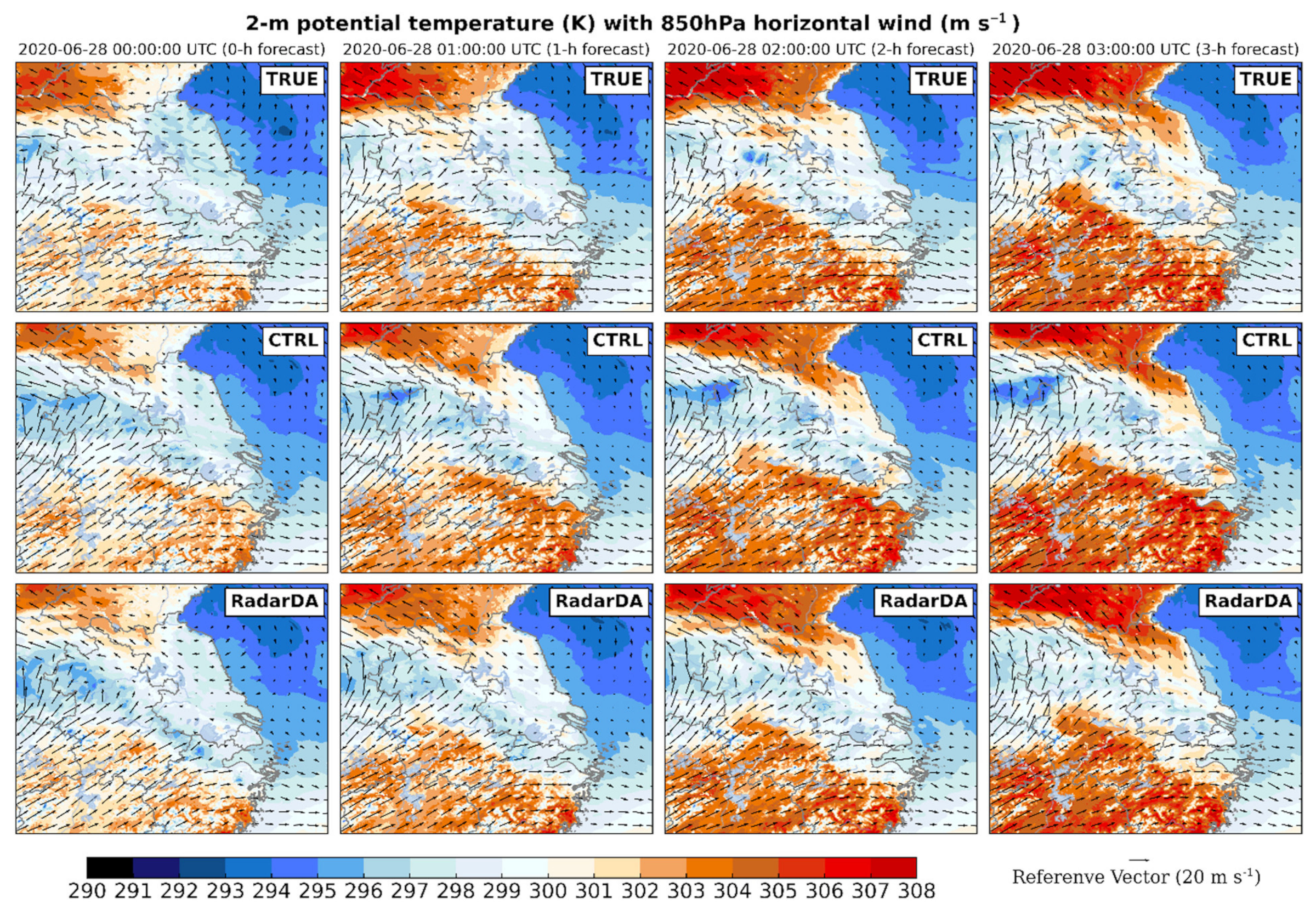Hydrometeor and Latent Heat Nudging for Radar Reflectivity Assimilation: Response to the Model States and Uncertainties
Abstract
:1. Introduction
2. Methodology and Experiment Design
2.1. Deriving Hydrometeors from Radar Reflectance Factor
2.2. Hydrometeor and Latent Heat Nudging (HLHN)
- (i)
- A grid is marked as 0:
- (ii)
- A grid is marked as 1, both and are 0:
- (iii)
- A grid is marked as 1, One of or is 0:
- (iv)
- A grid marked as 1, both and are not 0:
2.3. Model Configuration and Weather Case Description
2.4. Experiment Design
2.5. Evaluation Method
3. Baseline Radar Reflectivity Data Assimilation
4. Observing System Simulation Experiments (OSSEs)
4.1. The Correlation between Relaxation Coefficient and “Ramp-Down” Issue
4.2. Sensitivity on Data Update Intervals
4.3. Sensitivity on Time Duration of Continuous Assimilation
4.4. Respone of the Model Temprature, Moisture and Winds

5. Discussion and Conclusions
- (1)
- The nudging relaxation coefficient G plays a key role in HLHN. For the summer Meiyu precipitation in China, 1E-3 was found as an appropriate value for G. Analysis shows that for more complex and rapidly changing weather systems, a larger G may be desired. In contrast, for relatively stable small and medium-scale weather, G should be set to a smaller value. Note that in general the nudging tendency term should not dominate the change of model variables in order for the adjustment not to damage the dynamic consistency. The imbalanced model states caused by overly strong HLHN forcing can lead to serious “ramp-down” issues right after the assimilation period ends.
- (2)
- The efficiency of HLHN depends on the balance between nudging coefficients, assimilation intervals, and the convection system’s evolving speed. For fast-developing and moving convection systems, a higher assimilation interval provides a gentle and smooth nudging effect.
- (3)
- HLHN requires a minimum assimilation duration to spin up the model clouds with dynamical and thermodynamical consistency. For the summer Meiyu precipitation studied, this time is ~1 h. When the assimilation duration is extended to 2 h, both analysis and forecasting gain proper assimilation effects. With a further increase of the assimilation duration, more improvement is seen but the improvement effect is gradually slowed down. It should be noted that the minimum duration depends on the initial model error and the development speed of the weather system.
- (4)
- In the first three hours of free forecasting, HLHN effectively improves the model clouds as well as temperatures, moisture, and winds of the model. Although HLHN does not directly adjust these model parameters, the spatiotemporal adjustment of the hydrometeors makes a positive effect on the overall model states. However, in order to spin up convection that was missed in the model, HLHN tends to add excessive latent heat into the model, resulting in an increase in upper-level updraft and snow content.
Author Contributions
Funding
Institutional Review Board Statement
Informed Consent Statement
Data Availability Statement
Acknowledgments
Conflicts of Interest
References
- Wilson, J.W.; Crook, N.A.; Mueller, C.K.; Sun, J.; Dixon, M. Nowcasting Thunderstorms: A Status Report. Bull. Am. Meteorol. Soc. 1998, 79, 2079–2099. [Google Scholar] [CrossRef]
- Lilly, D. Numerical prediction of thunderstorm—Has its time come? Q. J. R. Meteorol. Soc. 1990, 116, 779–798. [Google Scholar]
- Wilson, J.; Megenhardt, D.; Pinto, J. NWP and Radar Extrapolation: Comparisons and Explanation of Errors. Mon. Weather Rev. 2020, 148, 4783–4798. [Google Scholar] [CrossRef]
- Sun, J.; Xue, M.; Wilson, J.W.; Zawadzki, I.; Ballard, S.P.; Onvlee-Hooimeyer, J.; Joe, P.; Barker, D.; Li, P.-W.; Golding, B.; et al. Use of NWP for Nowcasting Convective Precipitation: Recent Progress and Challenges. Bull. Am. Meteorol. Soc. 2014, 95, 409–426. [Google Scholar] [CrossRef] [Green Version]
- Sun, J. Convective-scale assimilation of radar data: Progress and challenges. Q. J. R. Meteorol. Soc. 2005, 131, 3439–3463. [Google Scholar] [CrossRef]
- Jacques, D.; Zawadzki, I. The Impacts of Representing the Correlation of Errors in Radar Data Assimilation. Part I: Experiments with Simulated Background and Observation Estimates. Mon. Weather Rev. 2014, 142, 3998–4016. [Google Scholar] [CrossRef]
- Jacques, D.; Zawadzki, I. The Impacts of Representing the Correlation of Errors in Radar Data Assimilation. Part II: Model Output as Background Estimates. Mon. Weather Rev. 2015, 143, 2637–2656. [Google Scholar] [CrossRef]
- Chandrasekar, R.; Balaji, C. Impact of physics parameterization and 3DVAR data assimilation on prediction of tropical cyclones in the Bay of Bengal region. Nat. Hazards 2016, 80, 223–247. [Google Scholar] [CrossRef]
- Xiao, Q.; Kuo, Y.-H.; Sun, J.; Lee, W.-C.; Lim, E.; Guo, Y.-R.; Barker, D. Assimilation of Doppler Radar Observations with a Regional 3DVAR System: Impact of Doppler Velocities on Forecasts of a Heavy Rainfall Case. J. Appl. Meteorol. 2005, 44, 768–788. [Google Scholar] [CrossRef]
- Sugimoto, S.; Crook, N.A.; Sun, J.; Xiao, Q.; Barker, D. An Examination of WRF 3DVAR Radar Data Assimilation on Its Capability in Retrieving Unobserved Variables and Forecasting Precipitation through Observing System Simulation Experiments. Mon. Weather Rev. 2009, 137, 4011–4029. [Google Scholar] [CrossRef]
- Benjamin, S.G.; Dévényi, D.; Weygandt, S.S.; Brundage, K.J.; Brown, J.M.; Grell, G.A.; Kim, D.; Schwartz, B.E.; Smirnova, T.G.; Smith, T.L.; et al. An Hourly Assimilation–Forecast Cycle: The RUC. Mon. Weather Rev. 2004, 132, 495–518. [Google Scholar] [CrossRef]
- Sun, J. Initialization and Numerical Forecasting of a Supercell Storm Observed during STEPS. Mon. Weather Rev. 2005, 133, 793–813. [Google Scholar] [CrossRef]
- Sun, J.; Chen, M.; Wang, Y. A Frequent-Updating Analysis System Based on Radar, Surface, and Mesoscale Model Data for the Beijing 2008 Forecast Demonstration Project. Weather Forecast. 2010, 25, 1715–1735. [Google Scholar] [CrossRef]
- Kawabata, T.; Kuroda, T.; Seko, H.; Saito, K. A Cloud-Resolving 4DVAR Assimilation Experiment for a Local Heavy Rainfall Event in the Tokyo Metropolitan Area. Mon. Weather Rev. 2011, 139, 1911–1931. [Google Scholar] [CrossRef]
- Sun, J.; Wang, H. Radar Data Assimilation with WRF 4D-Var. Part II: Comparison with 3D-Var for a Squall Line over the U.S. Great Plains. Mon. Weather Rev. 2013, 141, 2245–2264. [Google Scholar] [CrossRef]
- Snyder, C.; Zhang, F. Assimilation of Simulated Doppler Radar Observations with an Ensemble Kalman Filter*. Mon. Weather Rev. 2003, 131 Pt 1, 1663–1677. [Google Scholar] [CrossRef] [Green Version]
- Tong, M.; Xue, M. Ensemble Kalman Filter Assimilation of Doppler Radar Data with a Compressible Nonhydrostatic Model: OSS Experiments. Mon. Weather Rev. 2005, 133, 1789–1807. [Google Scholar] [CrossRef] [Green Version]
- Zhang, F.; Weng, Y.; Sippel, J.A.; Meng, Z.; Bishop, C. Cloud-Resolving Hurricane Initialization and Prediction through Assimilation of Doppler Radar Observations with an Ensemble Kalman Filter. Mon. Weather Rev. 2009, 137, 2105–2125. [Google Scholar] [CrossRef] [Green Version]
- Jones, C.D.; MacPherson, B. A latent heat nudging scheme for the assimilation of precipitation data into an operational mesoscale model. Meteorol. Appl. 1997, 4, 269–277. [Google Scholar] [CrossRef]
- Haase, G.; Crewell, S.; Simmer, C.; Wergen, W. Assimilation of radar data in mesoscale models: Physical initialization and latent heat nudging. Phys. Chem. Earth Part B Hydrol. Ocean. Atmos. 2000, 25, 1237–1242. [Google Scholar] [CrossRef]
- Stephan, K.; Klink, S.; Schraff, C. Assimilation of radar-derived rain rates into the convective-scale model COSMO-DE at DWD. Q. J. R. Meteorol. Soc. 2008, 134, 1315–1326. [Google Scholar] [CrossRef]
- Radhakrishnan, C.; Chandrasekar, V. CASA Prediction System over Dallas–Fort Worth Urban Network: Blending of Nowcasting and High-Resolution Numerical Weather Prediction Model. J. Atmos. Ocean Technol. 2020, 37, 211–228. [Google Scholar] [CrossRef]
- Tian, X.; Zhang, H.; Feng, X.; Xie, Y. Nonlinear Least Squares En4DVar to 4DEnVar Methods for Data Assimilation: Formulation, Analysis, and Preliminary Evaluation. Mon. Weather Rev. 2018, 146, 77–93. [Google Scholar] [CrossRef]
- Liu, C.; Xiao, Q.; Wang, B. An Ensemble-Based Four-Dimensional Variational Data Assimilation Scheme. Part I: Technical Formulation and Preliminary Test. Mon. Weather Rev. 2008, 136, 3363–3373. [Google Scholar] [CrossRef] [Green Version]
- Wang, X.; Snyder, C.; Hamill, T.M. On the Theoretical Equivalence of Differently Proposed Ensemble–3DVAR Hybrid Analysis Schemes. Mon. Weather Rev. 2007, 135, 222–227. [Google Scholar] [CrossRef]
- Li, Y.; Wang, X.; Xue, M. Assimilation of Radar Radial Velocity Data with the WRF Hybrid Ensemble–3DVAR System for the Prediction of Hurricane Ike (2008). Mon. Weather Rev. 2012, 140, 3507–3524. [Google Scholar] [CrossRef] [Green Version]
- Duda, J.D.; Wang, X.; Wang, Y.; Carley, J.R. Comparing the Assimilation of Radar Reflectivity Using the Direct GSI-Based Ensemble–Variational (EnVar) and Indirect Cloud Analysis Methods in Convection-Allowing Forecasts over the Continental United States. Mon. Weather Rev. 2019, 147, 1655–1678. [Google Scholar] [CrossRef]
- Benjamin, S.G.; Weygandt, S.S.; Brown, J.M.; Hu, M.; Alexander, C.R.; Smirnova, T.G.; Olson, J.B.; James, E.; Dowell, D.C.; Grell, G.A.; et al. A North American Hourly Assimilation and Model Forecast Cycle: The Rapid Refresh. Mon. Weather Rev. 2016, 144, 1669–1694. [Google Scholar] [CrossRef]
- Ingleby, N.B.; Lorenc, A.C.; Ngan, K.; Rawlins, F.; Jackson, D.R. Improved variational analyses using a nonlinear humidity control variable. Q. J. R. Meteorol. Soc. 2013, 139, 1875–1887. [Google Scholar] [CrossRef]
- Tang, Y.; Lean, H.W.; Bornemann, J. The benefits of the Met Office variable resolution NWP model for forecasting convection. Meteorol. Appl. 2013, 20, 417–426. [Google Scholar] [CrossRef]
- Stephan, K.; Schraff, C. Improvements of the operational latent heat nudging scheme used in COSMO-DE at DWD. COSMO Newsl. 2008, 9, 7–11. [Google Scholar]
- Jacques, D.; Michelson, D.; Caron, J.-F.; Fillion, L. Latent Heat Nudging in the Canadian Regional Deterministic Prediction System. Mon. Weather Rev. 2018, 146, 3995–4014. [Google Scholar] [CrossRef]
- Davolio, S.; Buzzi, A. A Nudging Scheme for the Assimilation of Precipitation Data into a Mesoscale Model. Weather Forecast. 2004, 19, 855–871. [Google Scholar] [CrossRef]
- Liu, Y.; Vandenberghe, F.; Low-Nam, S.; Warner, T.; Swerdlin, S. Observation-quality estimation and its application in the NCAR/ATEC real-time FDDA and forecast (RTFDDA) system. Bull. Am. Meteorol. Soc. 2004, 1, 31–40. [Google Scholar]
- Liu, Y.; Xu, M.; Roux, G.; Ge, M.; Sheu, R.; Hacker, J.; Swerdlin, S. A FDDA Based Operational Mesoscale Ensemble Analysis and Prediction System (E-RTFDDA) and a Comparison of MM5 and WRF. 2007. Available online: https://citeseerx.ist.psu.edu/viewdoc/download?doi=10.1.1.503.1545&rep=rep1&type=pdf (accessed on 22 September 2021).
- Liu, Y.; Warner, T.T.; Bowers, J.F.; Carson, L.P.; Chen, F.; Clough, C.A.; Davis, C.A.; Egeland, C.H.; Halvorson, S.F.; Huck, T.W.; et al. The Operational Mesogamma-Scale Analysis and Forecast System of the U.S. Army Test and Evaluation Command. Part I: Overview of the Modeling System, the Forecast Products, and How the Products Are Used. J. Appl. Meteorol. Clim. 2008, 47, 1077–1092. [Google Scholar] [CrossRef] [Green Version]
- Liu, Y.; Warner, T.T.; Astling, E.G.; Bowers, J.F.; Davis, C.A.; Halvorson, S.F.; Rife, D.L.; Sheu, R.-S.; Swerdlin, S.P.; Xu, M. The Operational Mesogamma-Scale Analysis and Forecast System of the U.S. Army Test and Evaluation Command. Part II: Interrange Comparison of the Accuracy of Model Analyses and Forecasts. J. Appl. Meteorol. Clim. 2008, 47, 1093–1104. [Google Scholar] [CrossRef] [Green Version]
- Pan, Y.; Xue, M.; Ge, G. Incorporating Diagnosed Intercept Parameters and the Graupel Category within the ARPS Cloud Analysis System for the Initialization of Double-Moment Microphysics: Testing with a Squall Line over South China. Mon. Weather Rev. 2016, 144, 371–392. [Google Scholar] [CrossRef]
- Albers, S.C.; McGinley, J.A.; Birkenheuer, D.L.; Smart, J.R. The Local Analysis and Prediction System (LAPS): Analyses of Clouds, Precipitation, and Temperature. Weather Forecast. 1996, 11, 273–287. [Google Scholar] [CrossRef] [Green Version]
- Lerach, D.G.; Rutledge, S.A.; Williams, C.; Cifelli, R. Vertical Structure of Convective Systems during NAME 2004. Mon. Weather Rev. 2010, 138, 1695–1714. [Google Scholar] [CrossRef] [Green Version]
- Xu, M.; Liu, Y.; Davis, C.A.; Warner, T.T. 2002: Sensitivity of nudging parameters on the performance of a mesoscale FDDA system: A case study. In Proceedings of the 15th Conference on NumericaL Weather Prediction, San Antonio, TX, USA, 12–16 August 2002; pp. 127–130. [Google Scholar]
- Thompson, G.; Field, P.R.; Rasmussen, R.M.; Hall, W.D. Explicit Forecasts of Winter Precipitation Using an Improved Bulk Microphysics Scheme. Part II: Implementation of a New Snow Parameterization. Mon. Weather Rev. 2008, 136, 5095–5115. [Google Scholar] [CrossRef]
- Grell, G.A.; Freitas, S.R. A scale and aerosol aware stochastic convective parameterization for weather and air quality modeling. Atmos. Chem. Phys. 2014, 14, 5233–5250. [Google Scholar] [CrossRef] [Green Version]
- Hong, S.-Y.; Noh, Y.; Dudhia, J. A New Vertical Diffusion Package with an Explicit Treatment of Entrainment Processes. Mon. Weather Rev. 2006, 134, 2318–2341. [Google Scholar] [CrossRef] [Green Version]
- Iacono, M.; Delamere, J.S.; Mlawer, E.J.; Shephard, M.W.; Clough, S.A.; Collins, W. Radiative forcing by long-lived greenhouse gases: Calculations with the AER radiative transfer models. J. Geophys. Res. Space Phys. 2008, 113, 1–8. [Google Scholar] [CrossRef]
- Fairall, C.W.; Bradley, E.F.; Hare, J.E.; Grachev, A.A.; Edson, J.B. Bulk parameterization of air-sea fluxes: Updates and verification for the COARE algorithm. J. Clim. 2003, 16, 571–591. [Google Scholar] [CrossRef]
- Pan, S.; Gao, J.; Stensrud, D.J.; Wang, X.; Jones, T.A. Assimilation of Radar Radial Velocity and Reflectivity, Satellite Cloud Water Path, and Total Precipitable Water for Convective-Scale NWP in OSSEs. J. Atmos. Ocean. Technol. 2018, 35, 67–89. [Google Scholar] [CrossRef]
- Zhu, K.; Xue, M.; Ouyang, K.; Jung, Y. Assimilating polarimetric radar data with an ensemble Kalman filter: OSSEs with a tornadic supercell storm simulated with a two-moment microphysics scheme. Q. J. R. Meteorol. Soc. 2020, 146, 1880–1900. [Google Scholar] [CrossRef]
- Roberts, N.M.; Lean, H.W. Scale-Selective Verification of Rainfall Accumulations from High-Resolution Forecasts of Convective Events. Mon. Weather Rev. 2008, 136, 78–97. [Google Scholar] [CrossRef]
- Han, M.; Braun, S.A.; Matsui, T.; Williams, C.R. Evaluation of cloud microphysics schemes in simulations of a winter storm using radar and radiometer measurements. J. Geophys. Res. Atmos. 2013, 118, 1401–1419. [Google Scholar] [CrossRef]
- Koch, S.E.; Ferrier, B.; Stoelinga, M.T.; Szoke, E.; Weiss, S.J.; Kain, J.S. The use of Simulated Radar Reflectivity Fields in the Diagnosis of Mesoscale Phenomena from High-Resolution WRF Model Forecasts. 2005. Available online: https://www.researchgate.net/publication/228873463_The_use_of_simulated_radar_reflectivity_fields_in_the_diagnosis_of_mesoscale_phenomena_from_high-resolution_WRF_model_forecasts (accessed on 22 September 2021).
- Hu, M.; Xue, M. Impact of configurations of rapid intermittent assimilation of wsr-88d radar data for the 8 may 2003 oklahoma city tornadic thunderstorm case. Mon. Weather Rev. 2007, 135, 507–525. [Google Scholar] [CrossRef] [Green Version]
- Johnson, A.; Wang, X. Design and Implementation of a GSI-Based Convection-Allowing Ensemble Data Assimilation and Forecast System for the PECAN Field Experiment. Part I: Optimal Configurations for Nocturnal Convection Prediction Using Retrospective Cases. Weather Forecast. 2017, 32, 289–315. [Google Scholar] [CrossRef]
- Hu, M.; Xue, M.; Brewster, K. 3DVAR and Cloud Analysis with WSR-88D Level-II Data for the Prediction of the Fort Worth, Texas, Tornadic Thunderstorms. Part I: Cloud Analysis and Its Impact. Mon. Weather Rev. 2006, 134, 675–698. [Google Scholar] [CrossRef]
- Ding, Y. Summer Monsoon Rainfalls in China. J. Meteorol. Soc. Jpn. 1992, 70, 373–396. [Google Scholar] [CrossRef] [Green Version]
- Kato, K. Airmass Transformation over the Semiarid Region around North China anc Abrupt Change in the Structure of the Baiu Front in Early Summer. J. Meteorol. Soc. Jpn. 1987, 65, 737–750. [Google Scholar] [CrossRef] [Green Version]
- Zhu, Y.; Liu, E.; Mahajan, R.; Thomas, C.; Groff, D.; Van Delst, P.; Collard, A.; Kleist, D.; Treadon, R.; Derber, J.C. All-Sky Microwave Radiance Assimilation in NCEP’s GSI Analysis System. Mon. Weather. Rev. 2016, 144, 4709–4735. [Google Scholar] [CrossRef]
- Qian, X.; Qiu, B.; Zhang, Y. Widespread Decline in Vegetation Photosynthesis in Southeast Asia Due to the Prolonged Drought During the 2015/2016 El Niño. Remote Sens. 2019, 11, 910. [Google Scholar] [CrossRef] [Green Version]
- Wang, J.; Zhang, L.; Guan, J.; Zhang, M. Evaluation of Combined Satellite and Radar Data Assimilation with POD-4DEnVar Method on Rainfall Forecast. Appl. Sci. 2020, 10, 5493. [Google Scholar] [CrossRef]














| Hydrometeor | Mixing Ratio | ||
|---|---|---|---|
| Rain | 1000 | ||
| Snow | 100 | ||
| Hail | 913 | ||
| Graupel | 400 |
| Group | Experiment | Da Duration | Da Interval | Relaxation Coefficient G |
|---|---|---|---|---|
| Group A | G2E-3 | 2000–0000UTC | 6 min | G = 2E-3 |
| G1E-3 | 2000–0000UTC | 6 min | G = 1E-3 | |
| G5E-4 | 2000–0000UTC | 6 min | G = 5E-4 | |
| G2E-4 | 2000–0000UTC | 6 min | G = 2E-4 | |
| Group B | INT6min | 2000–0000UTC | 6 min | G = 1E-3 |
| INT12min | 2000–0000UTC | 12 min | G = 1E-3 | |
| INT30min | 2000–0000UTC | 30 min | G = 1E-3 | |
| INT60min | 2000–0000UTC | 60 min | G = 1E-3 | |
| Group C | DUR 4 h | 2000–0000UTC | 6 min | G = 1E-3 |
| DUR 3 h | 2100–0000UTC | 6 min | G = 1E-3 | |
| DUR 2 h | 2200–0000UTC | 6 min | G = 1E-3 | |
| DUR 1 h | 2100–0000UTC | 6 min | G = 1E-3 |
Publisher’s Note: MDPI stays neutral with regard to jurisdictional claims in published maps and institutional affiliations. |
© 2021 by the authors. Licensee MDPI, Basel, Switzerland. This article is an open access article distributed under the terms and conditions of the Creative Commons Attribution (CC BY) license (https://creativecommons.org/licenses/by/4.0/).
Share and Cite
Huo, Z.; Liu, Y.; Wei, M.; Shi, Y.; Fang, C.; Shu, Z.; Li, Y. Hydrometeor and Latent Heat Nudging for Radar Reflectivity Assimilation: Response to the Model States and Uncertainties. Remote Sens. 2021, 13, 3821. https://doi.org/10.3390/rs13193821
Huo Z, Liu Y, Wei M, Shi Y, Fang C, Shu Z, Li Y. Hydrometeor and Latent Heat Nudging for Radar Reflectivity Assimilation: Response to the Model States and Uncertainties. Remote Sensing. 2021; 13(19):3821. https://doi.org/10.3390/rs13193821
Chicago/Turabian StyleHuo, Zhaoyang, Yubao Liu, Ming Wei, Yueqin Shi, Chungang Fang, Zhuozhi Shu, and Yang Li. 2021. "Hydrometeor and Latent Heat Nudging for Radar Reflectivity Assimilation: Response to the Model States and Uncertainties" Remote Sensing 13, no. 19: 3821. https://doi.org/10.3390/rs13193821
APA StyleHuo, Z., Liu, Y., Wei, M., Shi, Y., Fang, C., Shu, Z., & Li, Y. (2021). Hydrometeor and Latent Heat Nudging for Radar Reflectivity Assimilation: Response to the Model States and Uncertainties. Remote Sensing, 13(19), 3821. https://doi.org/10.3390/rs13193821







